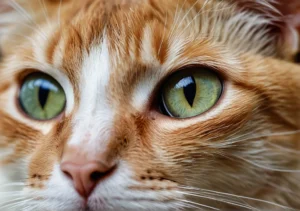Orange cats are often associated with being feral, but have you ever wondered why? Let’s explore the reasons behind this common misconception.
Orange Cats: Why Are They Often Considered Feral?
The Myth of the Feral Orange Cat
Let’s debunk a common myth – the idea that orange cats are more likely to be feral. This misconception might stem from the fact that orange cats are more prevalent in outdoor environments where feral cats often roam. However, color does not determine a cat’s behavior.
Cats of all colors can exhibit feral behaviors depending on their upbringing and experiences. It’s essential to understand that each cat is an individual with its own personality, regardless of its coat color. So, next time you see an orange cat, don’t jump to conclusions about its behavior based on its color alone.
Genetics of Orange Cats
Have you ever wondered why some cats sport that vibrant orange hue? It all comes down to genetics. The gene responsible for orange fur is located on the X chromosome. Male cats only have one X chromosome, so if they inherit the orange gene, they will be orange. On the other hand, female cats need two copies of the gene to display the orange color.
This genetic factor not only determines a cat’s color but can also influence their behavior. Some studies suggest that male orange cats may be more assertive and dominant, while female orange cats can be more reserved. However, remember that behavior is a result of various factors, not just genetics.
Behavioral Traits in Orange Cats
Orange cats are often perceived as feral due to their independent and assertive nature. These cats are typically known for their strong personalities, often displaying confidence and a hint of stubbornness. Their tendency to roam and explore their surroundings can also contribute to the misconception of them being feral.
One unique behavioral trait among orange cats is their playful and energetic nature. They are often curious and enjoy engaging in interactive play, which can sometimes be misunderstood as aggressive behavior. Additionally, orange cats are known to be vocal communicators, expressing their needs and desires through meows and purrs.
It’s important to understand that while orange cats may exhibit these strong-willed behaviors, they are not inherently feral. With proper socialization and care, orange cats can make loving and affectionate companions just like cats of any other color.
Mythbusting: Dispelling Common Myths
Orange cats are not all feral: While some orange cats may exhibit feral behaviors, it is not a trait specific to their color. Feral tendencies can be influenced by a variety of factors such as socialization, environment, and past experiences.
Orange cats are not more aggressive: The misconception that orange cats are more aggressive than other colors is simply not true. Aggression in cats is usually related to individual temperament and upbringing rather than coat color.
Orange cats are not bad luck: Contrary to superstitions, owning an orange cat does not bring bad luck. In fact, many cultures view orange cats as symbols of good fortune and prosperity.
Orange cats are not more prone to health issues: There is no scientific evidence to suggest that orange cats are more susceptible to health problems compared to cats of other colors. Like all cats, they require regular veterinary care to stay healthy.
Orange cats are not less trainable: While orange cats may have a reputation for being independent, they are just as capable of learning tricks and commands as any other cat. Patience and positive reinforcement are key when training any feline companion.
By debunking these common myths, we can better understand and appreciate orange cats for the unique and wonderful pets they are.
Famous Orange Cats in Pop Culture
When it comes to famous orange cats in pop culture, one iconic feline that comes to mind is Garfield. Known for his love of lasagna and witty one-liners, Garfield has certainly shaped how many people view orange cats. Another well-known orange cat is Simba from Disney’s “The Lion King,” portraying a regal and courageous character. These portrayals of orange cats in popular media can influence our perceptions, sometimes associating them with humor, confidence, or bravery. Remember, every cat is unique, regardless of their color or breed.
Conservation Efforts for Feral Cats
Conservation efforts for feral cats play a crucial role in maintaining the balance of our ecosystem. Feral cats, including orange ones, often face challenges such as lack of proper care, food, and shelter. Trap-neuter-return programs are essential in controlling feral cat populations while ensuring their well-being. By providing support to organizations dedicated to feral cat conservation, we can help these cats live healthier lives and reduce their impact on wildlife. Remember, every little bit counts in making a difference.
Additional Unique Insight:
- Community Involvement: Engaging with local communities to raise awareness about feral cat conservation can have a significant impact. Encouraging responsible pet ownership and promoting spaying and neutering programs can help prevent the overpopulation of feral cats while creating a more compassionate society towards these animals.
Why Are Orange Cats Feral?
Orange cats aren’t naturally feral; rather, external factors often lead to this misconception. One common reason for feral behavior in orange cats is lack of socialization at a young age. Cats that haven’t been properly exposed to humans or other animals may exhibit more aggressive or fearful tendencies. Additionally, abandonment or past traumas can also contribute to a cat’s feral behavior. It’s essential to approach feral orange cats with patience and understanding, as they may require extra time and care to adjust to domestic life.
Tips for Caring for Orange Cats
When caring for orange cats, whether domesticated or feral, it’s crucial to provide a safe and nurturing environment. Establish a consistent feeding schedule to build trust and routine with your cat. Spend quality time playing and interacting with your cat to strengthen your bond. Ensure access to a comfortable resting space and provide mental stimulation through toys and scratching posts. Regular veterinary check-ups are essential to monitor your cat’s health and address any potential issues early on. Lastly, consider seeking professional help if your orange cat displays feral behavior to ensure their well-being.
Interesting Facts About Orange Cats
Orange cats, also known as ginger or marmalade cats, are not only striking in appearance but also have some unique qualities. Did you know that most orange cats are male? This is due to genetics, as the orange color is linked to the X chromosome. Additionally, orange cats are often known for their friendly and affectionate demeanor. Some people believe that orange cats bring good luck, with tales of these felines being considered lucky charms in various cultures. Remember, each orange cat has its own personality and quirks, making them truly special companions.
Alex, a passionate animal lover, has experience in training and understanding animal behavior. As a proud pet parent to two dogs and three cats, he founded AnimalReport.net to share insights from animal experts and expand his knowledge of the animal kingdom.




